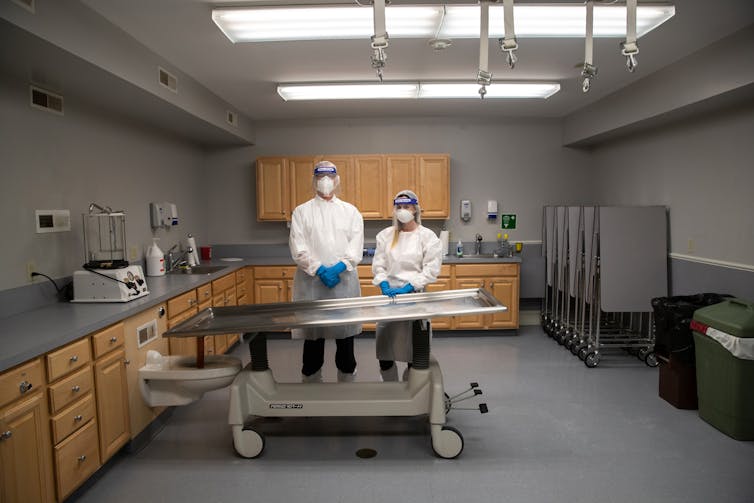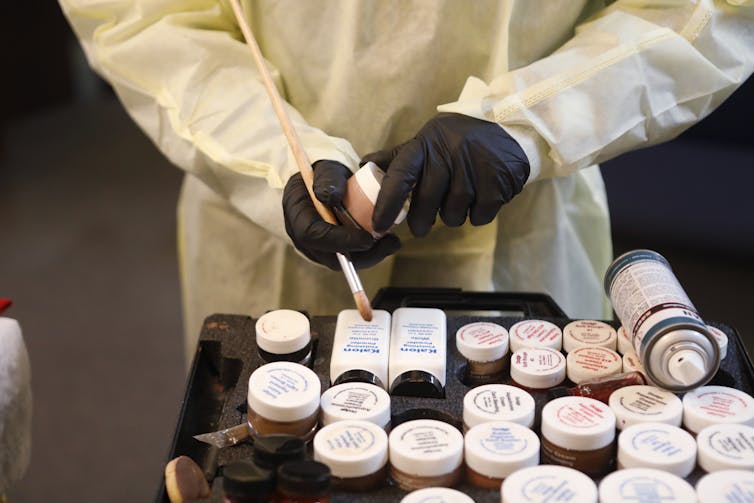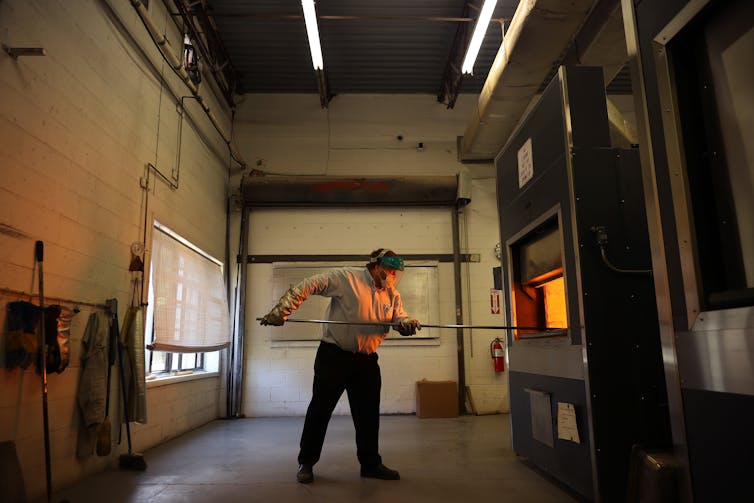When someone dies, what happens to the body?
- Written by Mark Evely, Program Director and Assistant Professor of Mortuary Science, Wayne State University
Upwards of 2.8 million people die[1] every year in the United States. As a funeral director who heads a university mortuary science program, I can tell you that while each individual’s life experiences are unique, what happens to a body after death follows a broadly predictable chain of events.
In general, it depends on three things: where you die, how you die and what you or your family decide on for funeral arrangements and final disposition.
In death’s immediate aftermath
Death can happen anywhere: at home; in a hospital, nursing or palliative care facility; or at the scene of an accident, homicide or suicide.
A medical examiner or coroner must investigate whenever a person dies unexpectedly while not under a doctor’s care. Based on the circumstances of the death, they determine whether an autopsy is needed. If so, the body travels to a county morgue or a funeral home, where a pathologist conducts a detailed internal and external examination of the body as well as toxicology tests.
Once the body can be released, some states allow for families to handle the body themselves, but most people employ a funeral director. The body is placed on a stretcher, covered and transferred from the place of death – sometimes via hearse, but more commonly these days a minivan carries it to the funeral home.
State law determines who has the authority to make funeral arrangements and decisions about the remains. In some states, you can choose during your lifetime how you’d like your body treated when you die. In most cases, however, decisions fall on surviving family or someone you appointed before your death.
Preparing the body for viewing
In a 2020 consumer survey conducted by the National Funeral Directors Association, 39.4% of respondents reported feeling it’s very important to have the body or cremated remains present[2] at a funeral or memorial service.
To prepare for that, the funeral home will usually ask whether the body is to be embalmed. This process sanitizes the body, temporarily preserves it for viewing and services, and restores a natural, peaceful appearance. Embalming is typically required for a public viewing and in certain other circumstances, including if the person died of a communicable disease or if the cremation or burial is to be delayed for more than a few days.
 A funeral home director and an intern stand by a mortuary table.
John Moore/Getty Images News via Getty Images[3]
A funeral home director and an intern stand by a mortuary table.
John Moore/Getty Images News via Getty Images[3]
When the funeral director begins the embalming process, he places the body on a special porcelain or stainless steel table that looks much like what you’d find in an operating room. He washes the body with soap and water and positions it with the hands crossed over the abdomen, as you’d see them appear in a casket. He closes the eyes and mouth.
Next the funeral director makes a small incision near the clavicle, to access the jugular vein and carotid artery. He inserts forceps into the jugular vein to allow blood to drain out, while at the same time injecting embalming solution into the carotid artery via a small tube connected to the embalming machine. For every 50 to 75 pounds of body weight, it takes about a gallon of embalming solution, largely made up of formaldehyde. The funeral director then removes excess fluids and gases from the abdominal and thoracic cavities using an instrument called a trocar. It works much like the suction tube you’ve experienced at the dentist.
Next the funeral director sutures any incisions. He grooms the hair and nails and again washes the body and dries it with towels. If the body is emaciated or dehydrated, he can inject a solution via hypodermic needle to plump facial features. If trauma or disease has altered the appearance of the deceased, the embalmer can use wax, adhesive and plaster to recreate natural form.
 A funeral director prepares to apply makeup to a man who died of COVID-19.
Octavio Jones/ Getty Images North America via Getty Images[4]
A funeral director prepares to apply makeup to a man who died of COVID-19.
Octavio Jones/ Getty Images North America via Getty Images[4]
Lastly, the funeral director dresses the deceased and applies cosmetics. If the clothing provided does not fit, he can cut it and tuck it in somewhere that doesn’t show. Some funeral homes use an airbrush to apply cosmetics; others use specialized mortuary cosmetics or just regular makeup you might find at a store.
Toward a final resting place
If the deceased is to be cremated without a public viewing, many funeral homes require a member of the family to identify him or her. Once the death certificate and any other necessary authorizations are complete, the funeral home transports the deceased in a chosen container to a crematory. This could be onsite or at a third-party provider.
 More people in the U.S. are now cremated than embalmed and buried.
Chip Somodevilla/Getty Images North America via Getty Images[5]
More people in the U.S. are now cremated than embalmed and buried.
Chip Somodevilla/Getty Images North America via Getty Images[5]
Cremations are performed individually. Still in the container, the deceased is placed in the cremator, which produces very high heat that reduces the remains to bone fragments. The operator removes any metal objects, like implants, fillings and parts of the casket or cremation container, and then pulverizes the bone fragments. He then places the processed remains in the selected container or urn. Some families choose to keep the cremated remains, while others bury them, place them in a niche or scatter them.
The year 2015 was the first year that the cremation rate exceeded the casketed burial rate[6] in the U.S., and the industry expects that trend to continue.
When earth burial is chosen, the casket is usually placed in a concrete outer burial container before being lowered into the grave. Caskets can also be entombed in above-ground crypts inside buildings called mausoleums. Usually a grave or crypt has a headstone of some kind that bears the name and other details about the decedent.
Some cemeteries have spaces dedicated to environmentally conscious “green” burials in which an unembalmed body can be buried in a biodegradable container. Other forms of final disposition are less common. As an alternative to cremation, the chemical process of alkaline hydrolysis can reduce remains to bone fragments. Composting involves placing the deceased in a vessel with organic materials like wood chips and straw to allow microbes to naturally break down the body.
[Deep knowledge, daily. Sign up for The Conversation’s newsletter[7].]
I’ve seen many changes over the course of my funeral service career, spanning more than 20 years so far. For decades, funeral directors were predominantly male, but now mortuary school enrollment nationwide is roughly 65% female. Cremation has become more popular. More people pre-plan their own funerals. Many Americans do not have a religious affiliation and therefore opt for a less formal service.
Saying goodbye is important for those who remain, and I have witnessed too many families foregoing a ceremony and later regretting it. A dignified and meaningful farewell and the occasion to share memories and comfort each other honors the life of the deceased and facilitates healing[8] for family and friends.
References
- ^ 2.8 million people die (www.cdc.gov)
- ^ body or cremated remains present (www.census.gov)
- ^ John Moore/Getty Images News via Getty Images (www.gettyimages.com)
- ^ Octavio Jones/ Getty Images North America via Getty Images (www.gettyimages.com)
- ^ Chip Somodevilla/Getty Images North America via Getty Images (www.gettyimages.com)
- ^ cremation rate exceeded the casketed burial rate (nfda.org)
- ^ Sign up for The Conversation’s newsletter (theconversation.com)
- ^ honors the life of the deceased and facilitates healing (www.jstor.org)
Authors: Mark Evely, Program Director and Assistant Professor of Mortuary Science, Wayne State University
Read more https://theconversation.com/when-someone-dies-what-happens-to-the-body-143070


